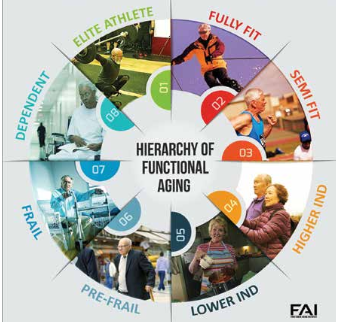On the spectrum of physical ability, where do you rank? More importantly, where do you want to rank?
Let’s look at a five-point scale. Most people over 50 fall into one of these categories.
1. Elite athlete
2. Fit
3. Independent
4. Frail
5. Dependent
We’ll look at each in more detail below. But take a guess now which one applies to you. How does that make you feel? Surely no one wants to think of themselves as dependent or frail – and everyone’s fitness goals are different, ranging from healthy function to high-level sports competition. That’s what’s so liberating about a healthy lifestyle: It lets you live the way you want to live, whatever that means to you. Come in and let us help you enjoy getting to where you want to be or maintaining your fitness level in fun, new ways. Exercise is the best medicine – and, no, it’s not too late to start.

FROM ELITE TO DEPENDENT
Here’s how the Functional Aging Institute (FAI) breaks down the stages, with broad direction on how people in each group can benefit from small group training. It’s a good structure to begin a discussion.
ELITE
Description: These are the most healthy and functional folks; those who are regular exercisers and probably involved in recreational sports. They have advanced physical abilities, and they love working hard at their fitness. Outlook: “Given their advanced physical abilities, there is really no limit on what they can do in a training session,” says FAI’s Dr. Cody Sipe.
FIT
Description: Most fit mature adults are considered fit in the area in which they train, but might be deficient in other areas. Maybe a runner has low strength, or a strong man has poor flexibility. There’s such a big range here that FAI notes the distinction between “fully fit” and “semi-fit.” Outlook: “They need a heavier focus on the specific areas in which they are deficient,” Sipe says.
INDEPENDENT
Description: The average mature adult can perform daily tasks on their own, but they don’t participate in any vigorous activities. This is the largest category, and some mature adults get trapped in complacency here, thinking that their independence means they don’t need to exercise. But that can lull them into a dangerous place, where one fall or injury can knock them down to “frail” or “dependent” status. Outlook: “This group needs a well rounded mix with a focus on increasingly complex movements and those that challenge dynamic balance.”
FRAIL
Description: People at this stage have low functional abilities in most or all aspects – strength, poor balance, energy, etc. They need help performing everyday tasks. FAI notes a wide range here and now counts “frail” and “prefrail” distinctions. Outlook: “They require an emphasis on basic strength and power exercises, as well as basic gait and mobility patterns. Balance movements should be more static and performed with caution because they have a high risk of falling.”
DEPENDENT
Individuals in this group typically require specialized one-on-one assistance and are not candidates for circuit training.
EVERYONE IS DIFFERENT
We know that you’re an individual, not a member of a demographic or even a subset on a scale like this. Functional fitness doesn’t necessarily track with chronological age. If you don’t know a super-fit 80-year-old, you’ve seen examples of them in the media. Sadly, it’s more likely that you know, perhaps someone who is 68 and frail. To live life on your own terms as you age, consider what you need to do to get or stay fit by your own definition, for your own purposes. That might include independence, fitness, or maybe even elite athleticism. You get to decide! Remember, progress not perfection!
(Content provided by Shelley Turk, Functional Aging Specialist and owner, ProActive Fitness)
-Shelley Turk

Leave a Reply